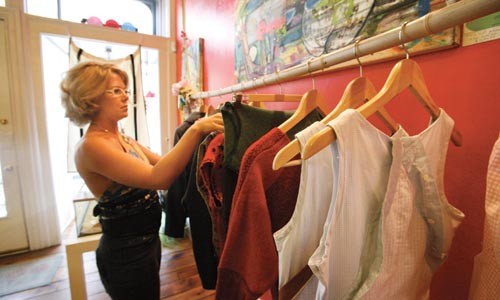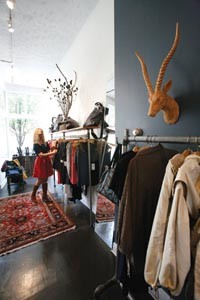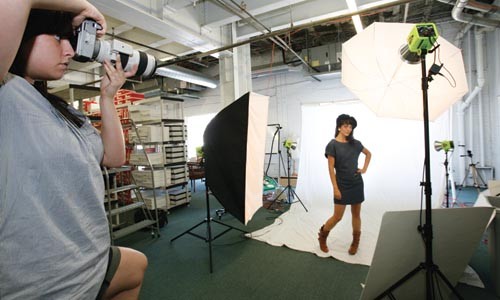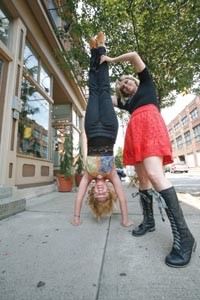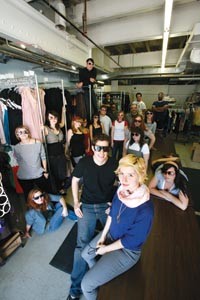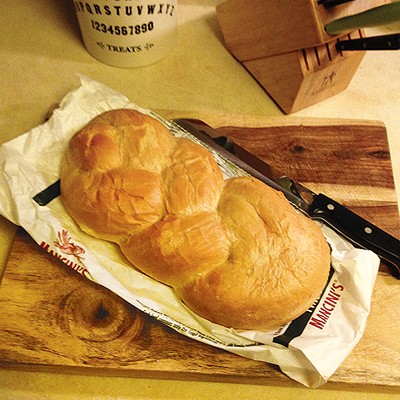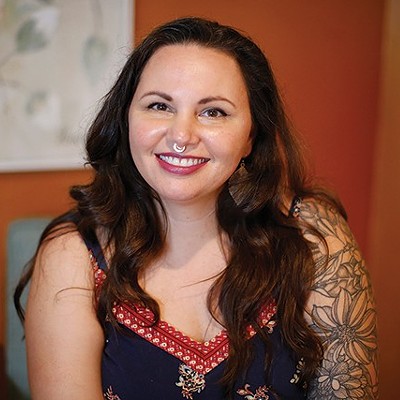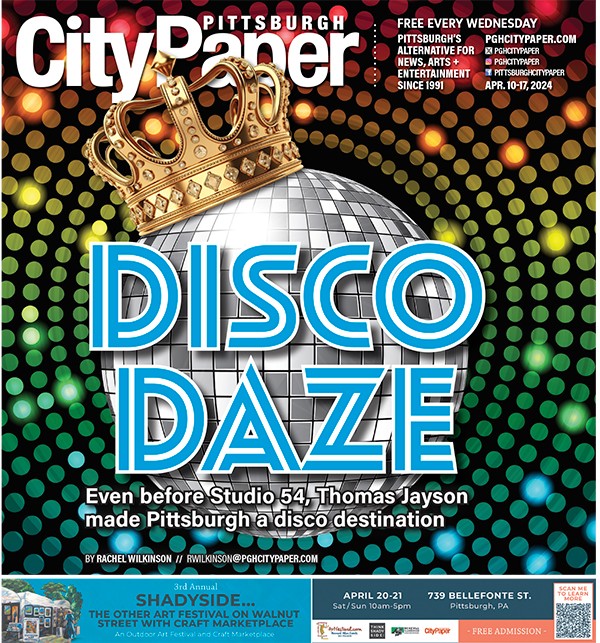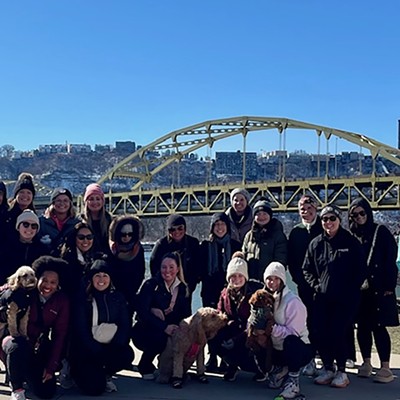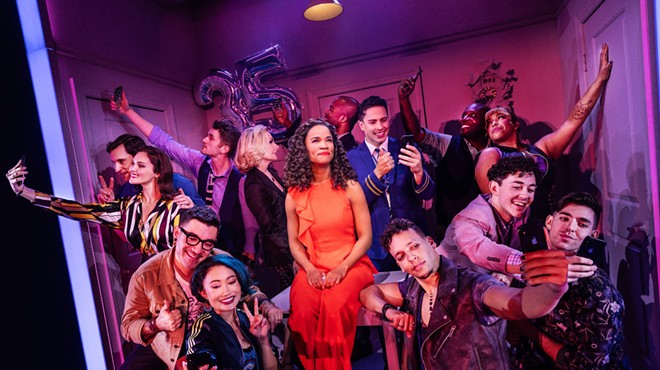LAS VEGAS -- Nevada's most famous city might once have possessed some gritty edge, a dangerous glamour, but it's been transformed into something else: Disneyland with no open-container laws or last call, a climate-controlled cash-suck sounding like an alarm-clock factory where something's gone horribly wrong.
And yet, it is here that the beautiful and stylish come to exchange their cultural currency, twice a year. It's here that Hawaiian designers' sun-saturated dress designs make their way into the hands of boutique owners from the deep South. It's here that scuzzy-chic Brooklynites at sweaty fashion-magazine parties dance the night away in custom graphic T-shirts from Japan.
And it is here that Pittsburgh designers and boutique owners vie with the best the world has to offer -- bringing the finest designs home to Steel City fashionistas, but also bringing Pittsburgh's home-grown design sense to shape the fashion world.
Over the next several days of scorching -- though, yes, dry -- mid-August heat, most of the big players will be focused on Magic, a trade-industry show that takes place at the Las Vegas Convention Center twice a year. Although Magic is the anchor for all the big-ticket doings, it's the smaller and more agile subsidiary, Pool, where the real action takes place.
Pool focuses on independent, emerging and art-driven brands. You won't find Nike tracksuits or Ralph Lauren blazers here. Instead, you might find tiny brands handmade by their designers, or dresses so edgy most people would think twice about wearing them. Yet the fashion industry depends on them.
"Pool is like Magic's cool indie-rock niece," says Susan Koger, owner of ModCloth.com, a Pittsburgh-based Internet boutique that has traveled to this fashion oasis in the desert to make purchases for its online store.
And a cool niece can reflect the consumer choices of an entire generation. "Independent and emerging design is at the very early stage of the fashion cycle," says Jin Su, associate professor in Indiana University of Pennsylvania's fashion-merchandising program.
A designer called emerging or independent is "someone who's newly launched their collection, like under five years, or someone who still maintains a small size of a collection," says Gretchen Harnick, department director for the Art Institute of Pittsburgh's fashion-merchandising bachelor's degree program. "There are some designers who always want to appear to be emerging and never want to grow into Rag and Bone or Marc Jacobs and want to remain true to their [boutique] roots."
Pittsburgh's fashion industry has a role to play in all of that.
The words "Pittsburgh's fashion industry" could sound oxymoronic at first blush, and the contingent here at Pool is small: a pair of bricks-and-mortar boutiques that are making Lawrenceville a serious style destination; a massive online empire that began in the house of a Carnegie Mellon grad with a passion for vintage; and a designer whose dresses and separates are found all over the country. Being part of the Pittsburgh scene creates particular business challenges, they admit, but it also provides unique advantages.
And just as a cool indie-rock niece can define an entire trend, a handful of businesswomen from Pittsburgh have come here, to contribute their imprint onto a vast industry. Pittsburgh's fashion community has ripples worldwide -- outlets and designers from all over communicate with one another, and creative clothing gets into the hands of seekers worldwide.
As Su puts it, "The fashion industry needs these people. They are pushing the whole textile, apparel and retail industry forward."
About a week before getting on the flight to Vegas, for Pool, Kelly Simpson-Scupelli is on the phone in her Stanton Heights home, leaning over proofs of her lookbook, which is laid out on a huge drafting table under an energy-saving light bulb. Madonna tunes quietly pulse through her open, airy studio as Simpson-Scupelli and an intern juggle ironing and folding dresses to fill orders for the fall. Samples of the Spring 2009 collection hang tantalizingly in one corner. But right now, she's worrying about the colors in the photos -- blueberry and pomegranate and other tasty hues -- of her Spring '09 line. They have to pop: Her line, Kelly Lane, is tagged "Clothing With Color."
Simpson-Scupelli began the line in 2006, and she made her bones on dresses, to the point where she's perfected an immediately recognizable style of bright colors with bold printed accents. But now, she says, "I feel like I've established the dress thing. I'm starting to create more breadth in the line."
So this season, the self-taught former graphic designer is branching out. Her line now offers separates, like a cropped ivory jacket. It also shows off her ever-increasing technical skill: The clothes feature beautiful, complex ruching and paneling, and a standout piece showcases an all-around peplum on an off-the-shoulder sheath. It's all lovely, but also quite practical in making women with all body shapes more comfortable.
"I'm trying to be more attuned to the places women want to accentuate, places women want to hide," Simpson-Scupelli says. "My repertoire of technical understanding is growing -- I'm getting better at masking and accentuating."
The Spring '09 line will also be the first time Simpson-Scupelli has made the prints herself. In the past, she's found prints by scouting out vintage or vintage-inspired fabric. But now she's looking for inspiration close to home: She says the pattern of one print, for example, was inspired by wintertime walks with husband Peter through the neighborhood. Boxes on the print call to mind garages and sheds, and a chain-link motif provides curvy interest.
"It's repetition, the same thing but with different variations," she says.
The goal, of course, is to take patterns inspired by the streets of Lawrenceville and Stanton Heights, and bring them to some of the world's fashion capitals. In addition to Pool, Simpson-Scupelli has plans to take her designs to the famous Chelsea Hotel, in New York, later in September for an intimate room-sized show with two other lines, Feral Childe and Rebe, whose clothes complement her sensibilities.
The stakes are high, she acknowledges: The exposure to be gained at a gathering like Pool can either fulfill a designer's hopes or dash them. "In order for small lines like us to survive, we have to do this," Simpson-Scupelli says. But she's optimistic: "Even though the economy is crappy, I feel an energy about this show."
Even so, it's a fine line, because almost by definition, an independent designer can't afford to be too successful. Simpson-Scupelli herself had a near-miss with Macy's a few years back: The huge retailer placed an order, but she backed out at the last minute, realizing she'd have to compromise too much and would dilute her brand for her target audience--small and independent businesses and their clientele. In retrospect, Simpson-Scupelli's glad she did.
"The minute you start mass-producing, you cross a boundary," she says. "It's a bigger beast, it can eat you up and spit you out. It's not limited, it's not special. If you're in a mall, anyone can get it," she says.
Simpson-Scupelli's line hews closely to her own aesthetic: The clothes are very finely crafted by a single seamstress who is also Pittsburgh-based. "She's paid well, and she does great work," Simpson-Scupelli says. She adds that the communication that's developed between her and the seamstress is key to translating her designs to reality.
The line has been ahead of the curve, too, in terms of fabric sourcing. It's long made use of now-trendy bamboo, soy and other renewable materials. At Pool, she meets other emerging designers who share ideas and compare notes on eco-fabrics, which, she says, helps them all.
In any case, her line has already met with almost as much success as Simpson-Scupelli can handle. Twelve stores have brought in Kelly Lane Spring '09, which is now available at roughly three dozen boutiques throughout North America -- none of which are at the mall.
And early returns at Pool suggest the trend will continue. A booth at the show costs $4,000, but Simpson-Scupelli earned that from orders taken in her first day. She wrote up 12 solid orders for more than 400 pieces, and plenty of other potential buyers looked at her fall line and made notes. Some of those will likely be back to place orders of their own.
Simpson-Scupelli's role in the fashion industry may be small, and that may be just the way she likes it. But Su, of IUP, says that small, agile new brands like Kelly Lane help to drive whole economies. Designers working out of home studios, she says, are the ones that put new notions on the mass market's radar. A major example is eco-fashion, the trend toward using materials and production methods with minimal impact on the earth's resources.
Today, Su says, designers like Lane "lead the trend [with their] focus on fashion and environmental issues. These eco-textiles integrate technology into the fashion business."
Eventually, of course, such trends become part of the cultural mainstream, as fashion that appeals to young and fashion-forward consumers trickles into the mass market and becomes commonplace. But by then, independent designers will have found some new niche. Designs on the cutting edge, Su says, "reflect the fashion, economy and technology of the times."
Cutting a swath through the carpeted, narrow-aisled mayhem of the trade show are three young women who mean business. The scene in the Las Vegas convention center recalls some fairy tale of a Middle Eastern bazaar: loud and crowded, overwhelming with jostling and bumping. Three lesser shopping sharks might easily get lost in the fray. But not these women.
Sari Fisher is in skinny jeans, T-strap wedge shoes and a tank top with a shiny fuchsia bra peeking out. Lindsay Williams wears a royal-blue tube dress with peacock-feather earrings and a peacock-feather necklace. Susan Koger sports a grey cardigan and flats with a purple shift and lugs around a finely tooled, brown leather doctor-style bag. All the women are from ModCloth.com, a Pittsburgh-based online boutique: Fisher and Williams are buyers, and Koger is co-owner. Most of their clothes are from ModCloth, too.
"We never get left alone," Fisher says with a smile. Salesfolk trip over themselves to sell to the million-dollar business, but Fisher says they often make the wrong pitch: "If they say everyone's buying it, we don't want it."
"We want to provide the stuff you can't find at the mall," says Koger. "We want to show people out there a choice."
The three women consult on each potential buy, and something like a consensus is required before they'll place an order.
"Susan, did you see this?" Williams calls out as two lacy skirts go zooming by on a tall hanger in the tiny space of a booth full of staff and buyers. Two skirts -- a long, ivory one and a shorter black one, both in guipure that almost calls to mind Prada's baroque Fall '08 offerings -- are stopped in their tracks as the women debate them.
"The white's a little doily-ish ..." offers Williams. But they write up an order for the black one.
They've agreed upon about a dozen items from this vendor, which the salespeople have set aside on a rack. "Eight across," Koger says, gesturing across the entire rack.
"Eight across" means eight six-packs of each item. A six-pack is a standard unit for the smaller vendors in the juniors' section: two each of the item in small, medium and large. The size of ModCloth's potential customer base -- essentially, anyone with an Internet connection -- means the company can buy in volumes that would overwhelm a cottage-shop designer like Simpson-Scupelli.
In fact, the ModCloth women order so much they have to photograph and write descriptions of everything they buy. That way, they won't forget and order the same item they've already bought at a show in Barcelona or New York.
"Our quantities are really big for this holiday," Koger says, and most of the orders they place in Vegas will arrive in time for the winter gifting season.
ModCloth has been on a growth spurt lately: It recently outgrew the Friendship home where Koger lives with husband and co-owner, Eric, and now occupies a sprawling Strip District warehouse. One day, perhaps, a retail outlet is in the cards, but just keeping up with skyrocketing online growth is enough for now.
Nineteen full-time employees labor daily to fill orders, create and post minutely accurate photos and descriptions of items and do customer service. The warehouse floor is like an apparel cave, with signs bearing labels and arrows on the huge shelves: Flats, this way. Here be wedges.
The ability to buy in volume means ModCloth can tap big-name designers if it wants. "Indie" may be ModCloth's watchword, but "I'd carry something from Tommy Hilfiger if it was cute," Koger says -- though at this point that's purely hypothetical. Small to midsize brands like Tulle or Stop Staring! actually fit the bill. "Some brands align more with our point of view, so we'll carry them more."
That point of view skews young, with bright takes on retro styles and crafty tropes like owls and sea monsters abounding. ModCloth brands like Nick & Mo, BB Dakota and E.C. Star aren't exactly on the edge, but they aren't generally available at Macy's, either. For some smaller brands, Koger says, ModCloth may be their largest buyer.
And that gives the retailer additional leverage. "A vendor will bring us multiple samples," says Koger. "We'll see stuff that hasn't gone into production yet" and make comments on it, which often as not determines what is finally created. "It's nice to have a hand in what the designers are actually making. I mean, we are the customer."
Of course, there's no reason for an online clothing retailer to be based on Pittsburgh, of all places. But there's no reason not to be based here either.
Online boutiques "have consumers from not only the U.S. and Mexico and Asian countries, but all over the world," says IUP's Su. Older customers, who want to touch fabrics and see colors up close, may balk at buying online, she says, but not so the younger generation, who make the bulk of new fashion decisions anyway. A retailer like ModCloth has less overhead to worry about as well -- no need for fancy window displays or fitting rooms.
"The fashion industry is global," says Su. "The physical location is Pittsburgh, but all the production uses purchases from all countries globally -- all other people's hard work. The fashion industry connects every culture around the world."
Alissa Martin eyes up avant-garde shoes at the Irregular Choice booth at Pool, where a pair of bright-blue flat booties with long-tailed parrot appliqués cascading down the ankle catch her eye. She becomes almost breathless at ordering what will surely be the shoe of choice among Pittsburgh's high-heel wearing contingent this spring: In ivory, it's got an open, squared-off toe and black piping for a contrast that's wildly eye-catching. The tall heel is made up of stacked squares almost like letter-free Scrabble tiles, each one rotated just a little off the one below it. The effect is architectural, and fabulous.
"They take shoes as an art form," Martin says of Irregular Choice. She's long carried the line at Pavement, her store on Butler Street, in Lawrenceville. What's more, Irregular Choice is "boutique-friendly" in that it will accept smaller orders. That's crucial for her strictly bricks-and-mortar store, which maintains very little backstock and may sell only one or two pairs on a slow day.
Pavement's space is taken up mostly with shoes, though it does offer a limited assortment of clothes, jewelry and bags. But you don't have to scan the shelves to know that shoes are Martin's passion: She routinely hauls herself through airports, casinos and the convention center in a gorgeous pair of high blue wedges that tie off to the side.
"I'm gonna keep you away from dogs," says Andre Turner, Irregular Choice's U.S. manager, as he suggests styles for Martin and asks after her store. "I've done a lot of editing already."
But Martin has to do some winnowing of her own, editing that Turner can't do.
"People in Pittsburgh have a more muted palette," she says. And while a boutique owner from Los Angeles ogles a pair of classic bombshell pumps with conical heels, Martin is dismissive. "I don't think I could sell this," she says. "The suede is a deterrent." After all, if Pittsburghers are going to spend half of a rent check on a pair of shoes -- and many of her customers do -- those shoes had better not fall to pieces after one salty slog through wintertime streets. Pittsburghers are practical, Martin says, and despite their preference for more restrained colors, "they'll take a chance on color if the style is practical."
Materials aren't the only consideration for Pavement customers. "The right sizing is as important as the style: a disproportionate amount of [Pavement customers] wear an 8 ½ , 9," Martin says. "That's what I sell the most of. I can't give 6s away."
By contrast, says Turner, women in L.A. have tiny feet and go for "sexy sexy" tall heels. East Coast women, meanwhile, might choose the edgier sneakers that almost verge on throwback b-ball style, with feminine details.
A few doors down Butler street from Pavement at SUGAR, Katie Bulger offers elegantly, thoughtfully designed clothing for women -- mostly dresses, with separates and jewelry rounding out the offerings. The few lines she carries are ones she's intimately familiar with and wears herself -- lines like Kelly Lane, whose sundress she's wearing as she winnows through the trade show. She too views the offerings at Pool with a Pittsburgh eye. When combing the wares, Bulger keeps the preferences and body shapes of individual customers in mind.
As Gretchen Harnick, who once owned a boutique in Cleveland prior to heading up the Art Institute's fashion program, puts it, boutiques "buy really specifically for their customer."
Here at Pool, Bulger rewards customer service from designers as well. One booth offers intriguing designs, for example, but the designer snubs Bulger, the assistant who bothers to wait on her is poorly informed, and Bulger walks away. A few booths down, however, she find Fables by Barrie. It's bright retro stuff, like deeply modest romper-style bathing suits with brass buttons, satiny dresses with ruffles and high-waisted shorts. It's also a little edgy for Pittsburgh, but the designer comes right over to Bulger, asks about her boutique, and talks about her inspiration from nautical and rockabilly sources.
"Let's do it, let's write a small order," Bulger says after a bit of discussion. She goes for six pairs of the shorts, in small, medium and large in white and navy, and a funky short jumper that, if nothing else, will create a lot of interest in the store window. "It might just make somebody's day," she says, whether it sells or not.
The bricks-and-mortar joints don't have a very wide reach. But if their market isn't broad, it is deep.
"Boutique stores are very local," says Su. "They cater to the local people's lifestyle and socioeconomic status. They know the local people very well. They don't compete for volume, but they have their customer. Unlike a mass customer, those customers are very loyal."
And since those customers are seeking a distinctive look above all else, so must the boutique owner. Vendors who lose sight of that can be punished.
One of the booths that won't be getting a buy from Pittsburgh, for example, is Early Jewelry, a rural-inspired line by Kylie Grater, a Lawrence, Kan., native whose handmade jewelry clearly shows her roots without being all yee-haw about it. (An elegant round shape just happens to be a horseshoe, for instance.) A while back, Grater got a taste of the big time -- and unlike Simpson-Scupelli, actually went through with the deal.
"I did 6,000 pieces out of my home for Urban Outfitters," Grater says. "It blew up. It was hard to understand. As a young designer, I didn't know how to do it. It was too much."
Part of the problem, Grater says, is that "I don't outsource to factories," because contributing to the local economy is a must. As a result, the huge order stretched her to the limit: She had to push back smaller orders from independent boutiques and use cheaper materials.
While getting her name and work into a shopping-mall giant like Urban Outfitters with a relatively huge order certainly helped her bottom line immediately, it had repercussions.
Pavement had carried Early Jewelry before it was in Urban. After that, though, Martin says she felt burned. She won't be buying from Grater again: The uniqueness is gone.
It seems unlikely that such a thing could happen to a designer like Kelly Simpson-Scupelli ... in part because of the synergy she's established with boutiques like SUGAR and Pavement.
While presiding at her booth at Pool, Simpson-Scupelli wears a pair of knee-high boots she bought from Martin's store. In promotional materials, her models are often wearing Pavement shoes as well. Bulger, meanwhile, mostly wears Kelly Lane dresses when she's out and about. And while she didn't buy anything from Simpson-Scupelli at Pool -- no need to do that more than 2,000 miles from home -- about 40 new Kelly Lane items will be on offer at SUGAR this spring.
By building such networks, the women have "created their own fashion clique," says Harnick, of the Art Institute. "They can bounce ideas off each other. It's inspiration, not competition."
Renee Piechocki agrees. The director of the city's office of public art, Piechocki is also the co-author, with Tiffany Ludwig, of Trappings: Stories of Women, Power and Clothing. For Piechocki, "Clothes are a decision you make every day," and thus have the potential to be inspiring. (The book and continuing Web-based companion project interview women across the country, asking them what they wear to feel powerful.) And to her, seeing local and women-owned businesses support each other and do business -- locally and around the world -- are two sides of a wonderful equation.
Piechocki is a customer at SUGAR, and appreciates the offerings at Pavement (though her personal prohibition against wearing leather keeps her from doing much more than window-shopping). There's always the danger of getting too parochial, she allows: "You want to support local, but not to block out new ideas. Look at ModCloth -- they're selling to women all over." But Pittsburghers, she says, have a special reason for seeing the value of a local fashion industry that buyers and sellers at Pool already appreciate.
"It's cool when you can seek out what's local," Piechocki says. When she and Ludwig travel for the Trappings project, "We love to look at local things: local museums, local bookstores. That's what people are looking for -- something that's of a place."


